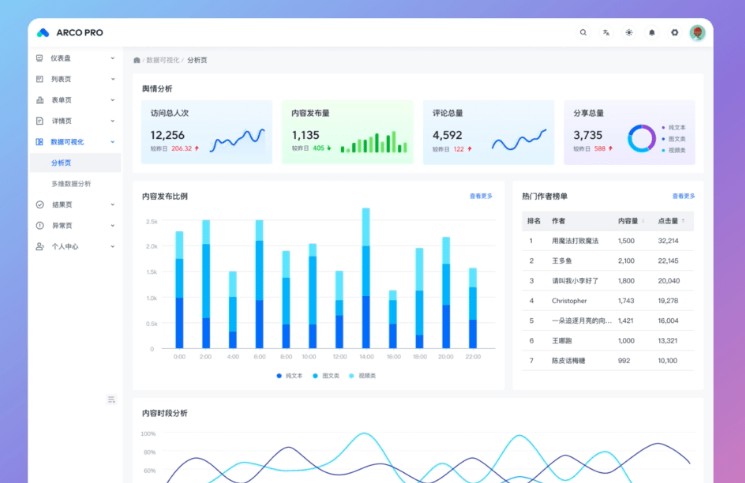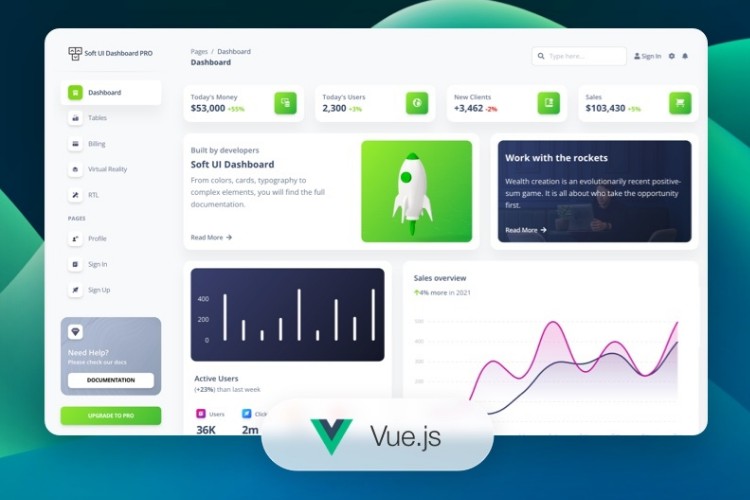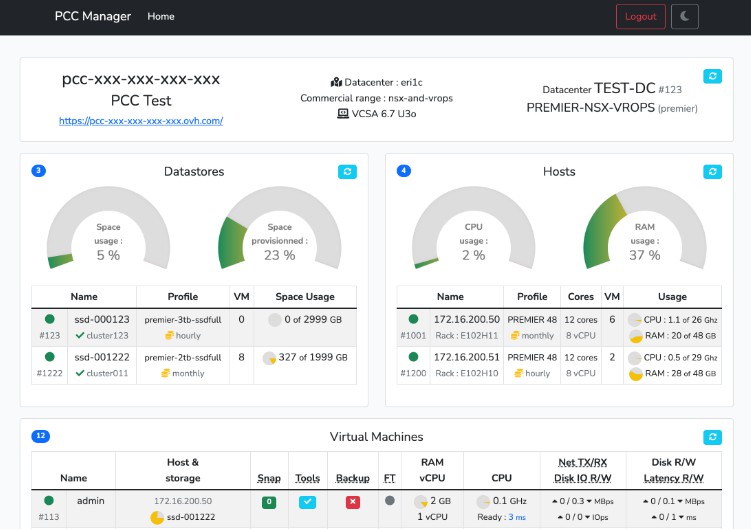Rancher Dashboard Test
Rancher Dashboard UI, a.k.a Cluster Explorer.
For the other Rancher UI (Cluster Manager) see rancher/ui.
Running for development
This is what you probably want to get started.
# Install dependencies
yarn install
# For development, serve with hot reload at https://localhost:8005
# using the endpoint for your Rancher API
API=https://your-rancher yarn dev
# or put the variable into a .env file
# Goto https://localhost:8005
Other building modes
# Build for standalone use within Rancher
# (These are done on commit/tag via Drone)
./scripts/build-embedded # for embedding into rancher builds
./scripts/build-hosted # for hosting on a static file webserver and pointing Rancher's ui-dashboard-index at it
# Output in dist/
# Build and run with server-side-rendering
# (This method and SSR are not currently used, but should be maintained for future)
yarn build
yarn start
# Develop via Docker instead of a local nodejs
docker build -f Dockerfile.dev -t dashboard:dev .
docker run -v $(pwd):/src \
-v dashboard_node:/src/node_modules \
-p 8005:8005 \
-e API=https://your-rancher \
dashboard:dev
# The first time will take *forever* installing node_modules into the volume; it will be faster next time.
# Goto https://localhost:8005
# Developing against a standalone "Steve" API on a Mac
git clone https://github.com/rancher/steve.git
cd steve
make run-host
cd dashboard
docker build -f Dockerfile.dev -t rancher/dashboard:dev .
docker run -v $(pwd):/src \
-v dashboard_node:/src/node_modules \
-p 8005:8005 \
-e API=http://172.17.0.1:8989 \
rancher/dashboard:dev
# The first time will take *forever* installing node_modules into the volume; it will be faster next time.
# Goto https://localhost:8005
What is it?
Dashboard is “stateless” client for the Rancher APIs built with Vue.js and NuxtJS. It is normally built and packaged as a folder of static HTML/CSS/JS files which are bundled into a Rancher release, with the index.html returned by the API server as the “fallback” case for any request that looks like it came from a browser and does not match an API URL.
Every k8s type, namespace, and operation that the logged in user has been granted access to is shown to them. The default view for everything is the raw YAML from the k8s API for detail pages, and the Table view column data for list pages (i.e. what you get from kubectl get <type> -o wide).
From there we can customize anything from what columns are shown and in what format to complete custom forms for graphically editing that resource instead of editing YAML.
Directory Structure
The directory structure is mostly flat, with each top level dir being for a different important thing (or just required by Nuxt to be there).
Customizing how k8s resources are presented
These are where you do most of the daily work of customizing of how a particular k8s resource is presented.
| Path | Used for |
|---|---|
| config | Configuration of how products look and work; constants for labels, types, cookies, query params, etc that are used |
| chart | Custom components to present when installing a Product chart |
| detail | Custom components to show as the detail view for a particular resource instance |
| edit | Custom components to show as the edit (or view config) view for a particular resource instance |
| list | Custom components to show as the list view for a resource type |
| models | Custom logic extending the standard resource-instance “class” for each API type and model returned by the API |
There is one Config entry for each “product”, which are the result of installing one of our helm charts to add a feature into Rancher such as Istio, monitoring, logging, CIS scans, etc. The config defines things like:
- The condition for when that product should appear (usually the presence of a type in a certain k8s API group)
- What types should appear in the left nav, how they’re labeled, grouped, ordered
- Custom table headers for each type
Helm charts have a generic installer control which lets you edit their values.yaml by default. To present a custom form for the user to configure a chart (especially the ones for our products), you create a matching chart/<name>.vue component, where the name corresponds to the catalog.cattle.io/ui-component annotation’s value on the chart.
Similarly, instead of a generic YAML detail or edit screen, you can provide your own component for any type in detail/<type>.vue or edit/<type>.vue. Detail components should generally use the <ResourceTabs> component to show the standard detail tabs + any specific ones you want to define. Edit components similarly generally use <CruResource>.
To customize the list view for a type, you can either change the header definitions (in config/) or provide a list/<type>.vue component to use instead of the standard one.
All objects returned from the API have a “base-class” (technically not really, but logically) of resource-instance. Every individual type can add additional behavior to its “sub-class” in models/<type>.js.
All <type>s throughout are the lowercased version of the k8s API group and kind, such as apps.deployment. Lowercase won’t matter in case-insensitive macOS but will break when built in CI or on Linux. Use the “Jump” menu in the UI to find the type you want and then copy the string out of the URL.
Other commonly changed stuff
| Path | Used for |
|---|---|
| assets | CSS, fonts, images, translations, etc resources which get processed during build |
| components | All general components which don’t have a separate special directory elsewhere |
| layouts | The outermost components for rendering different kinds of pages (Nuxt) |
| store | Vuex stores which maintain all the state for the life of a page load |
| utils | Misc parsers, utilities, and other (usually) standalone code that doesn’t fit anywhere else |
The rest
These are mostly standard Nuxt dirs that you won’t need to go into very often.
| Path | Used for |
|---|---|
| static | Static files which get directly copied into the build with no processing |
| middleware | Hooks called on every page load |
| mixins | Code that is defined once and then applied to several different other components |
| pages | The structure in here defines the routes that are available, and what gets rendered when one is hit |
| plugins | Add-ons to modify vue/nuxt or load additional 3rd-party code. The “steve” API client also notably lives here. |
| scripts | Shell scripts for building and related tasks, used by CI and npm run ... commands |
| server | Server-side middleware and dev SSL cert |
| test | Unit tests (or lack thereof) |
APIs
There are lots of different APIs available in Rancher, but the primary two are Norman and Steve:
- Norman is older and mainly used by the Ember UI. It presents an opinionated view of some of the common resources in a Kubernetes cluster, with lots of features to make the client’s life easier. Fields are renamed to be named more consistently, deeply-nested structures are flattened out somewhat, complicated multi-step interactions with the k8s API are orchestrated in the server and hidden from you, etc. It attempts to bridge the gap from Rancher 1.x’s usability, and is quite nice if it does what you need. But only the types that Norman supports are exposed, and you can only interact with the resources in the namespaces assigned to a Project. Types Norman doesn’t know about and namespaces not assigned to a project are effectively invisible.
- Steve is newer, and the primary one used here. It works in the opposite direction, starting with a completely unopinionated view of every resource available in a cluster, and then adding custom logic only where needed. Every type and every namespace are directly addressable. This still adds some critical functionality over directly talking to the k8s API, such as:
- It’s presented following our api-spec, so the same client libraries work for any of our APIs, including the in-browser generic api-ui.
- “Watches” to find out when a resource changes are aggregated into a single websocket which keeps track of what’s connected and can resume the stream, rather than many independent calls to the native k8s implementation
- The “counts” resource internally watches everything to keep track of how many of every type of resource there are in every namespace and state, which allows us to show all the types that are “in use” and how many there are in the left nav.
- Schemas and links on each resource efficiently identify what permissions the user making the request has, so that actions in the UI can be hidden or disabled if not allowed for the current user instead of letting them try and having the server reject it.
- Normalizing the different and sometimes inconsistent state/status/conditions data from resources into a single logical view of the world the UI can present.
- RPC-style actions to do more complicated workflows on the server side when appropriate
Endpoints
In a production setup these are all handled natively by Rancher. For development of dashboard, they are proxied to the Rancher install that the API environment variable points at.
| Endpoint | Notes |
|---|---|
/v3 |
Norman API |
/v3-public |
Norman unauthenticated API (mostly for info required to login) |
/v1 |
Steve API for the management (“local”) cluster |
/k8s/clusters/<id> |
Proxy straight to the native k8s API for the given downstream cluster |
/k8s/clusters/<id>/v1 |
Steve API for given downstream cluster via the server proxy |
Vuex Stores
There are 3 main stores for communicating with different parts of the Rancher API:
management: Points at the global-level “steve” API for Rancher as a whole.cluster: Points at “steve” for the one currently selected cluster; changes when you change clusters.rancher: Points at the “norman” API, primally for global-level resources, but some cluster-level resources are actually stored here and not physically in the cluster to be available to theclusterstore.
And then a bunch of others:
| Name | For |
|---|---|
| action-menu | Maintains the current selection for tables and handling bulk operations on them |
| auth | Authentication, logging in and out, etc |
| catalog | Stores the index data for Helm catalogs and methods to find charts, determine if upgrades are available, etc |
| github | Part of authentication, communicating with the GitHub API |
| growl | Global “growl” notifications in the corner of the screen |
| i18n | Internationalization |
| index | The root store, manages things like which cluster you’re connected to and what namespaces should be shown |
| prefs | User preferences |
| type-map | Meta-information about all the k8s types that are available to the current user and how they should be displayed |
| wm | “Window manager” at the bottom of the screen for things like container shells and logs. |
Synching state
The high-level way the entire UI works is that API calls are made to load data from the server, and then a “watch” is started to notify us of changes so that information can be kept up to date at all times without polling or refreshing. You can load a single resource by ID, an entire collection of all those resources, or something in between, and they should still stay up to date. This works by having an array of a single authoritative copy of all the “known” models saved in the API stores (management & cluster) and updating the data when an event is received from the “subscribe” websocket. The update is done on the existing copy, so that anything that refers to it finds out that it changed through Vue’s reactivity. When manipulating models or collections of results from the API, some care is needed to make sure you are keeping that single copy and not making extras or turning a “live” array of models into a “dead” clone of it.
The most basic operations are find({type, id}) to load a single resource by ID, findAll({type}) load all of them. These (anything starting with find) are async calls to the API. Getters like all(type) and byId(type, id) are synchronous and return only info that has already been previously loaded. See plugins/steve/ for all the available actions and getters.
Internationalization (i18n)
Any code producing messages, labels, numbers, dates, times, and the like should use the i18n store and translation strings to generate and format them instead of hardcoding English or American-isms anywhere. Messages and number formatting uses ICU templating for very powerful pluralization and customizing.
The assets/translations dir stores a YAML file with translations for each supported language.
- English is automatically used as the “fallback” if a particular key is missing from a non-English language.
- If you don’t have a native translation for a particular key, just leave that key out of the language
- Do not duplicate the English string into other languages.
Translations should be the largest phrase that makes sense as a single key, rather than several separate things rendered in a fixed order.
- For example “about 2 minutes remaining” should be a single translation:
About {n, number} {n, plural, one { minute }, other { minutes }} remaining. - Not one for
About, one forminute, one forminutes, one forremaining, and some code picking and choosing which to concatenate.
Server-Side-Rendering (SSR)
Nuxt supports server-side-rendering (SSR), where a node.js server runs the UI code on the server-side and responds with the fully-baked HTML of the desired page. This allows it to make all the necessary API calls directly “to itself”, with less latency, versus serving up an empty page which loads all the JS, then starts making API calls across the slower server<->user connection.
But actually using this mode would require a node.js process (with sometimes considerable overhead) running inside of every Rancher container, and coordination with Rancher to proxy requests that should be for the UI to it. So we don’t actually ship anything using this mode, Rancher releases use single-page-app (SPA) mode only.
We have no concrete plans for this, but can envision several situations where we might want to use SSR in the future, so maintaining the functionality is an engineering priority. Therefore SSR is on by default for development, and you should keep it that way in general. It is relatively easy to write something that will break in SSR, and if not exercised we’d end up with many different slightly broken things that add up to a large effort to ever get it running again if needed.
To disable it for the whole server for development, add --spa. To disable it for a single page load, add ?spa (or &spa) to the query string. It is harder, but possible, to write something that works in SSR but breaks in SPA, so these are good for debugging issues.
Contributing
For developers, after reading through the introduction on this page, head over to our Getting Started guide to learn more.
License
Copyright (c) 2014-2021 Rancher Labs, Inc.
Licensed under the Apache License, Version 2.0 (the “License”);
you may not use this file except in compliance with the License.
You may obtain a copy of the License at
http://www.apache.org/licenses/LICENSE-2.0
Unless required by applicable law or agreed to in writing, software
distributed under the License is distributed on an “AS IS” BASIS,
WITHOUT WARRANTIES OR CONDITIONS OF ANY KIND, either express or implied.
See the License for the specific language governing permissions and
limitations under the License.



